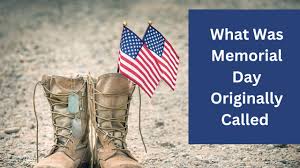what was memorial day originally called:-As we gather to honor those who have sacrificed their lives for our country, it’s important to remember the origins of Memorial Day. This federal holiday, observed on the last Monday of May, was not always known by its current name. Originally, it was called Decoration Day.
The Beginnings of Decoration Day
Decoration Day began after the American Civil War. The Civil War, which ended in 1865, resulted in the deaths of approximately 620,000 soldiers. The immense loss of life led to the establishment of national cemeteries. By the late 1860s, Americans in various towns and cities started holding springtime tributes to these countless fallen soldiers. They would decorate their graves with flowers and recite prayers.
First Official Observance
The first widely recognized observance of Decoration Day took place on May 30, 1868. This date was chosen by General John A. Logan, leader of an organization for Northern Civil War veterans. General Logan called for a nationwide day of remembrance, stating that May 30 was chosen because it wasn’t the anniversary of any specific battle.
On the first Decoration Day, General James Garfield made a speech at Arlington National Cemetery. Following the speech, 5,000 participants decorated the graves of the 20,000 Union and Confederate soldiers buried there. Similar ceremonies were held across the country.
Evolution into Memorial Day
Initially, Decoration Day was primarily recognized in the Northern states. The Southern states had their own separate days for honoring the dead. However, after World War I, the holiday evolved to commemorate American military personnel who died in all wars, not just the Civil War. This shift helped unify the observance across the country.
By the 20th century, the term Memorial Day began to gain traction. The name gradually became more common, and after World War II, it was used more frequently. It was not until 1967 that Memorial Day became the official name by federal law.
Memorial Day Becomes a Federal Holiday
In 1968, Congress passed the Uniform Monday Holiday Act. This act established Memorial Day as the last Monday in May to create a three-day weekend for federal employees. The change was intended to encourage more people to take time to remember the sacrifices made by military personnel. The law took effect in 1971, officially making Memorial Day a federal holiday.
Traditions of Memorial Day
Memorial Day traditions have evolved over the years. The holiday still involves decorating graves with flowers and flags. Many communities hold parades, and it’s a day for visiting cemeteries and memorials. In addition, a national moment of remembrance takes place at 3:00 p.m. local time.
- Parades: Many towns and cities host Memorial Day parades, featuring military personnel and members of veterans’ organizations. These parades often include marching bands and local community groups.
- Grave Decoration: Decorating graves remains a central tradition. Families and veterans’ organizations place flags, flowers, and wreaths on the graves of fallen soldiers.
- Remembrance Ceremonies: Various ceremonies take place at military cemeteries and war memorials. These ceremonies often include speeches, laying of wreaths, and playing of Taps.
- Moment of Remembrance: At 3:00 p.m. local time, Americans are encouraged to pause for a moment of remembrance. This moment of silence is a way to honor and reflect on the sacrifices made by military personnel.
The Meaning of Memorial Day
While Memorial Day is often associated with the beginning of summer and is marked by barbecues, picnics, and family gatherings, its true meaning goes deeper. It is a day to honor and remember the men and women who died while serving in the United States Armed Forces. It is a solemn reminder of the cost of freedom and the sacrifices made by those in uniform.
Challenges in Observance
Despite its significance, some feel that the true meaning of Memorial Day has been overshadowed by commercialism and leisure activities. Various veterans’ groups and military families strive to remind the public of the day’s purpose. Efforts include educational programs, public service announcements, and community events focused on remembrance.
How to Honor Memorial Day
To honor Memorial Day properly, consider engaging in activities that reflect its true purpose:
- Visit Cemeteries and Memorials: Pay your respects by visiting cemeteries and memorials, and placing flowers or flags on the graves of fallen soldiers.
- Attend Parades and Ceremonies: Participate in local parades and remembrance ceremonies to show support and gratitude.
- Educate Yourself and Others: Learn about the history of Memorial Day and share this knowledge with friends and family.
- Moment of Silence: Observe the national moment of remembrance at 3:00 p.m. to reflect on the sacrifices made by military personnel.
Conclusion
Memorial Day, originally known as Decoration Day, has a rich history rooted in the aftermath of the Civil War. Over the years, it has evolved into a day of remembrance for all American military personnel who have died in service to their country. While it is a time for family and community gatherings, it is also a solemn reminder of the cost of freedom. As we celebrate this day, let us take a moment to honor and remember the brave men and women who have given their lives for our nation.



